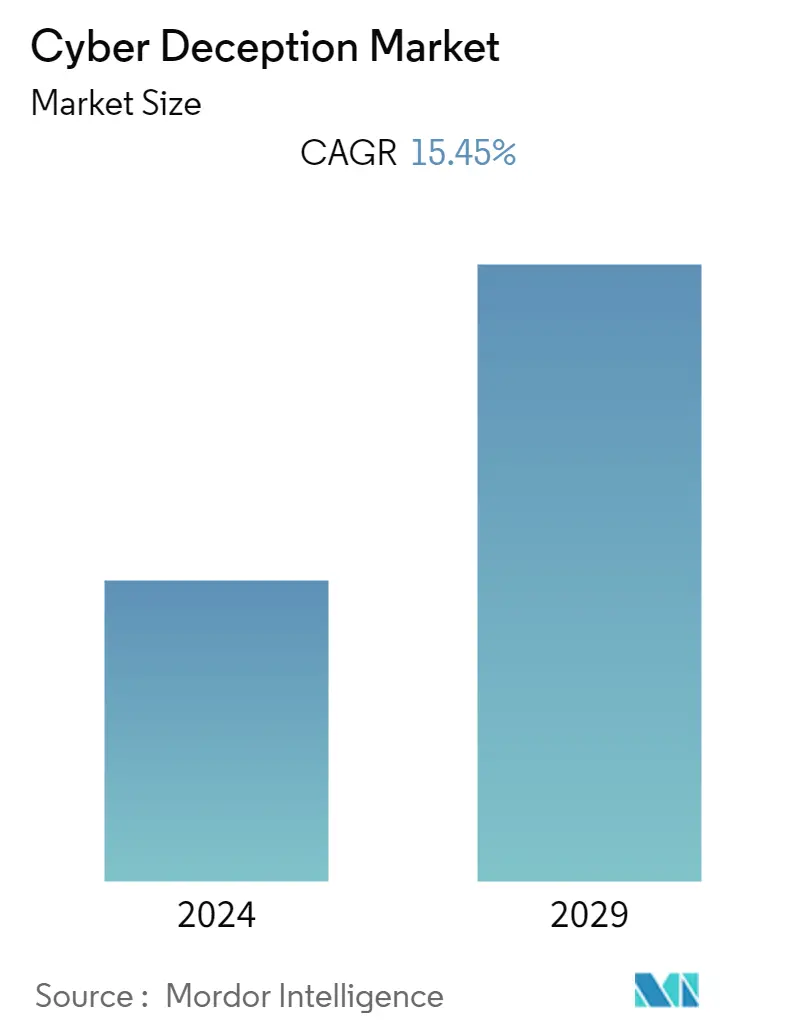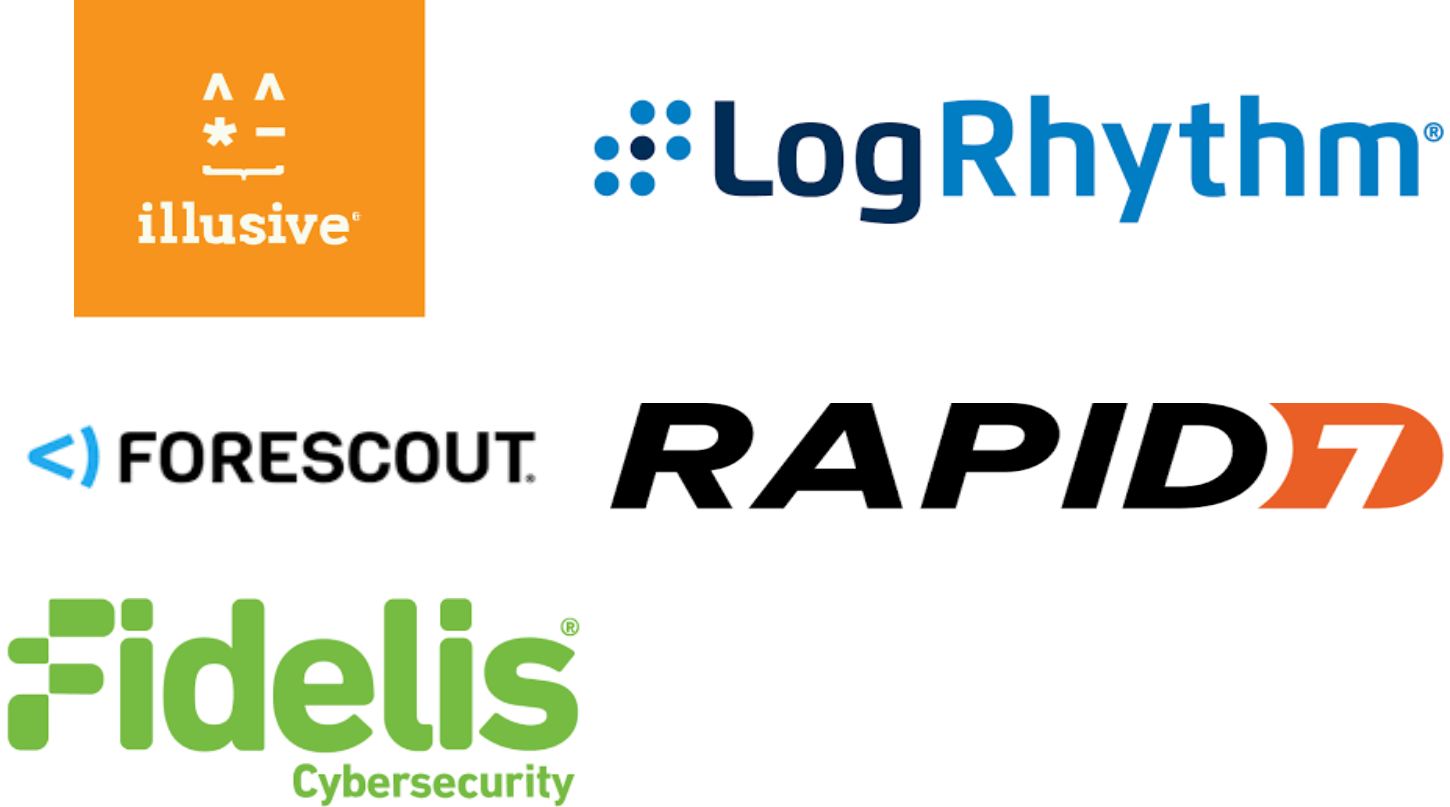Market Size of Cyber Deception Industry

| Study Period | 2019 - 2029 |
| Base Year For Estimation | 2023 |
| CAGR | 15.45 % |
| Fastest Growing Market | Asia Pacific |
| Largest Market | Asia Pacific |
| Market Concentration | Low |
Major Players
*Disclaimer: Major Players sorted in no particular order |
Cyber Deception Market Analysis
The cyber deception market is expected to witness a CAGR of 15.45%, during the forecast period (2021 - 2026). With the increasing number of internet and smartphone users across the globe, system breach is a common activity carried out by cyber-hackers to extract sensitive information, which can lead to unwanted cyber-attacks. Deception network, also called honeypot or decoy, is utilized to divert these kinds of attacks to other nodes and offer prior warnings to the administrator.
- The increasing adoption of the Internet of Things (IoT) is highlighting the cyber deception technology and promoting high usage, over conventional cybersecurity.
- Cyber deception market is driven by a rise in APT and zero-day attacks lined with the need for effective solutions for early detection of cyber attackers. Penetration of online as well as ATM transaction is influencing growth of cyber deception market in BFSI sector.
- Moreover, growing government funding in the financial industry across the world is likely to translate into growth of cyber deception market. The omnipresence of online and digital data and growth in cloud-based technology increases the vulnerability of these data, which in turn accelerates the growth of the cyber deception market.
- On the contrary, increasing use of pirated network tools in several emerging economies along with lack of cyber expertise will be one of the growth restraining determinant of the cyber deception market. Limitation of budget allocation in IT organizations and inability to meet technical requirements of the deceptive security tools are likely to hinder the cyber deception market.
Cyber Deception Industry Segmentation
System breaching is an activity carried out by cyber hacker to extract sensitive information which may lead to cyber-attacks. Cyber deception is one of the emerging trends in cyber defense systems. It is a controlled act to capture the network, create uncertainty and confusion against sudden attacks establishing situational awareness. Instances such as software infiltration and cloud-hacks increase the need for cyber deception solutions in several sectors. These solutions can identify, analyze, and protect against various forms of cyber-attacks in real time. The best-known attempts of cyber deception in different commercial sectors are honeypots and honeynets. Cyber deception solutions have been gaining increasing momentum to protect networks, devices from malicious attacks, ransom wares, sophisticated cybercriminals, and Advanced Persistent Threats (APTs).
| By Layer | |
| Application Security | |
| Network Security | |
| Data Security | |
| Endpoint Security |
| By Service Type | |
| Professional Service | |
| Managed Service |
| By End-user Vertical | |
| IT & Telecom | |
| Retail | |
| Energy & Power | |
| BFSI | |
| Healthcare | |
| Other End-user Verticals |
| Geography | |
| North America | |
| Europe | |
| Asia-Pacific | |
| Latin America | |
| Middle East & Africa |
Cyber Deception Market Size Summary
The cyber deception market is experiencing significant growth, driven by the increasing prevalence of cyber-attacks and the need for advanced security solutions. As cyber threats become more sophisticated, traditional cybersecurity measures are proving insufficient, leading to a heightened demand for cyber deception technologies. These technologies, which include honeypots and decoys, are designed to mislead and divert cyber attackers, providing early warnings and enhancing overall security. The rise in Internet of Things (IoT) adoption and the growing vulnerability of digital data, particularly in cloud-based environments, are further propelling the market. The financial sector, in particular, is witnessing increased investment in cyber deception solutions due to the high incidence of cyber threats and the need for robust security measures.
Despite the promising growth prospects, the cyber deception market faces challenges such as the use of pirated network tools in emerging economies and a lack of cyber expertise. Budget constraints within IT organizations and difficulties in meeting the technical requirements of deceptive security tools also pose obstacles to market expansion. The market is highly competitive, with numerous players offering a range of cybersecurity solutions. Key companies like LogRhythm, Rapid7, and Illusive Networks are at the forefront, continuously innovating to address the evolving threat landscape. Recent developments, such as LogRhythm's cloud-based NextGen SIEM Platform and Rapid7's acquisition of NetFort, highlight the industry's focus on enhancing security analytics and automation capabilities.
Cyber Deception Market Size - Table of Contents
-
1. MARKET DYNAMICS
-
1.1 Market Overview
-
1.2 Introduction to Market Drivers and Restraints
-
1.3 Market Drivers
-
1.3.1 Increasing Cyber Attacks to Drive the Market
-
1.3.2 Omnipresence of Online and Digital Data and Growth in Cloud-Based Technology Accelerates the Growth
-
-
1.4 Market Restraints
-
1.4.1 Increasing Use of Pirated Network Tools
-
1.4.2 Lack of Cyber Expertise
-
-
1.5 Industry Attractiveness - Porter's Five Force Analysis
-
1.5.1 Bargaining Power of Suppliers
-
1.5.2 Bargaining Power of Buyers/Consumers
-
1.5.3 Threat of New Entrants
-
1.5.4 Threat of Substitute Products
-
1.5.5 Intensity of Competitive Rivalry
-
-
-
2. MARKET SEGMENTATION
-
2.1 By Layer
-
2.1.1 Application Security
-
2.1.2 Network Security
-
2.1.3 Data Security
-
2.1.4 Endpoint Security
-
-
2.2 By Service Type
-
2.2.1 Professional Service
-
2.2.2 Managed Service
-
-
2.3 By End-user Vertical
-
2.3.1 IT & Telecom
-
2.3.2 Retail
-
2.3.3 Energy & Power
-
2.3.4 BFSI
-
2.3.5 Healthcare
-
2.3.6 Other End-user Verticals
-
-
2.4 Geography
-
2.4.1 North America
-
2.4.2 Europe
-
2.4.3 Asia-Pacific
-
2.4.4 Latin America
-
2.4.5 Middle East & Africa
-
-
Cyber Deception Market Size FAQs
What is the current Cyber Deception Market size?
The Cyber Deception Market is projected to register a CAGR of 15.45% during the forecast period (2024-2029)
Who are the key players in Cyber Deception Market?
LogRythm Inc., Rapid7 Inc., forescout technologies, Fidelis Cybersecurity (TopSpin Security) and Illusive Networks are the major companies operating in the Cyber Deception Market.

